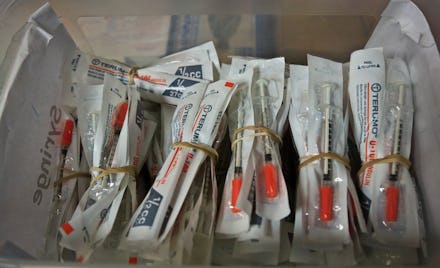Canada Is Experimenting With a Prescription Drug the U.S. Wouldn't Dare Touch

Heroin. In a move that's sparked debate across the Canadian health industry, 202 addicts are poised to receive the nation's first-ever shipment of legal prescription diacetylmorphine — commonly known as heroin.
Image Credit: AP
Straight reports the long-vilified opiate will be available at the Crosstown Clinic in East Vancouver, British Columbia.
Image Credit: Google Maps
There's a catch, of course: Only users who participated in a three-year treatment study launched in 2011, called the Study to Assess Long-term Opioid Maintenance Effectiveness (SALOME), will be eligible to receive it.
"They expect to be in a position to order the medication any day now," Adrienne Smith, a lawyer with the Pivot Legal Society, told Straight. "And then it takes 55 days to ship, so it's expected to arrive at the end of the year."
Background: While the decision may seem controversial, it stems from a fact the U.S. government wouldn't dare explore: Controlled heroin doses are very effective at treating addicts who don't respond to methadone.
As a "second-line" approach, Drug Policy Alliance reports that heroin-assisted treatment, or HAT, boasts a number of empirically proven benefits, like reduced illicit drug use, fewer deaths by overdose, lower crime rates and improved mental and physical health in patients.
Image Credit: AP
More: The Vancouver Sun also says HAT is remarkably cost-effective: An addict in heroin treatment costs society an estimated $1.09 million per year, compared to methadone's $1.14 million. This means HAT saves a net $156 million over the combined lifetimes of 2,000 male addicts age 25 to 36.
Much of the savings derive from addicts undergoing "maintenance" instead of engaging in destructive criminal behavior, according to the Sun.
Image Credit: AP
SALOME reaffirmed these findings. But as the study drew to a close, doctors and patients grew concerned that participants would be left behind without the effective new treatment to which they'd grown accustomed.
Hence the move to make it available.
But heroin as medicine? The concept remains foreign in a country such as the U.S., where an estimated $51 million a year is funneled into a failed and racist War on Drugs, according to the Drug Policy Alliance.
Heroin-assisted treatment is currently legal in seven countries, mostly in Europe, including the U.K., Spain, Germany and the Netherlands. And despite American studies that testify to its effectiveness, HAT remains subject to the same institutional resistance and research obstruction in the U.S. as medical marijuana has been for years.
This helps no one. Even with Health Canada's May ruling that sanctioned prescription heroin, Health Minister Rona Ambrose remains staunchly opposed:
"This decision is in direct opposition to the government's anti-drug policy," she said in a statement, according to the Vancouver Sun. "The special access program was designed to treat unusual cases and medical emergencies; it was not intended as a way to give illicit drugs to drug addicts."
The rhetoric of criminalization remains one of the major roadblocks to exploring the efficacy of potentially lifesaving treatments. If Canada's heroin experiment moves forward unhindered, one would hope the U.S. considers doing the same.